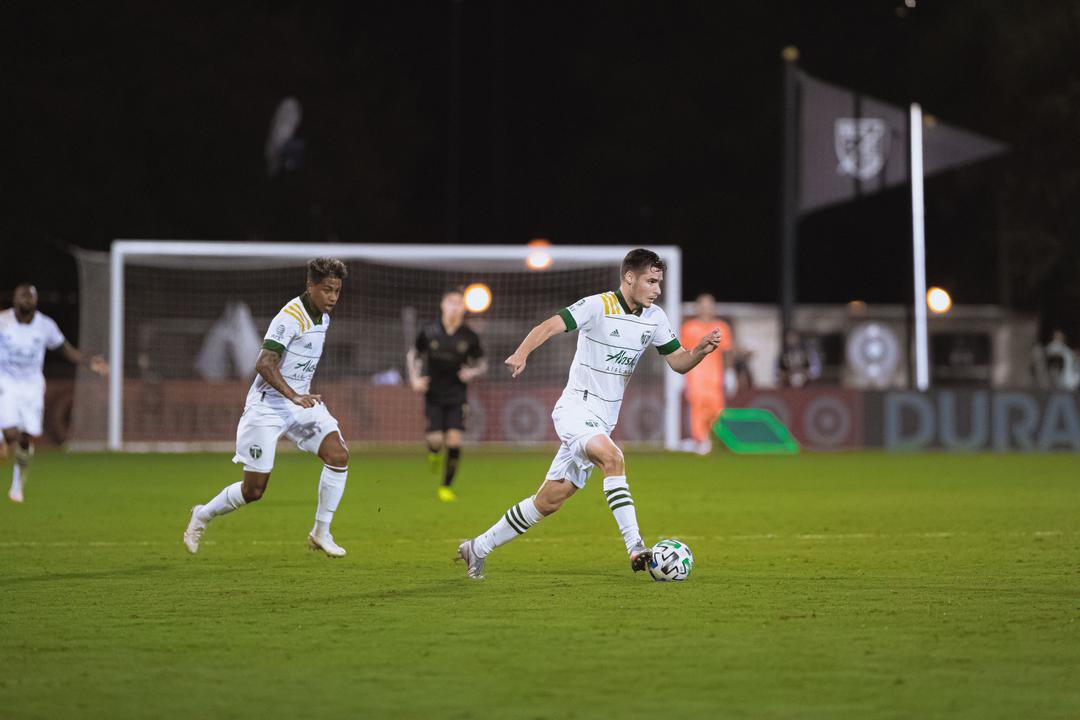Match after match, the Portland Timbers continue to impress.
Two games in, and it seems as if there’s something new and more creative to take away from each game—something that we did not see back in March.
Against the Los Angeles Galaxy, we saw an increased sense of confidence throughout the team that manifested itself through the team’s combination play and intricate movement. In its game against Houston, we saw a team both creating and exploiting space all around the field, playing long balls with a purpose to unlock the Dynamo defense while shutting down one of Major League Soccer’s most potent attacks.
Portland did it again on Thursday night, coming in with a disciplined and compact defensive shape that managed to contain what is usually a LAFC buzzsaw to win Group F.
I don’t have much to say to open this column other than just to mention how impressive this Portland team has been over three games. The shape that the Timbers played last night required a lot of discipline (which I will go into later). I mentioned on Twitter than containing LAFC for 90 minutes is a Herculean effort––both the Dynamo and Galaxy learned that over the past week––and Portland looked defensively solid for more than 75 percent of the game. I guess what I am saying is that the Timbers look primed to make a run in this tournament and that my outlook on the team is a lot brighter than what it was when I left Providence Park back in March.
And … I guess I should mention that I had to put my bonfire-building supplies away late into the match. It’s time for the Timbers to get revenge for what was an embarrassing defeat a season ago.
Goals
7′ – Jaroslaw niezgoda
The Timbers got out to a dream start against LAFC, striking first in the seventh minute.
Taking advantage of LAFC’s aggression, Portland found success in testing the opposing backline early and often. Thanks to ESPN’s aerial cam, it’s easy to see what went into Niezgoda’s opening goal, the Pole’s first as a Timber.
During this transitional moment, Portland creates a mini-overload on the right side of the field. During this, Niezgoda is sitting between the right center back and right back, waiting to pounce. The overload pulls Tristan Blackmon towards the sideline while Latif Blessing, the right back, is caught cheating a little too far up the field. This leaves Niezgoda with yards of space to run into, and he makes the finish look easy.
Conceding first is not a new trend for Bob Bradley’s men: They did it against both the Houston Dynamo and LA Galaxy. This may be looked back upon as an easy finish, but the goal proved vital for the Timbers, allowing them to weather 15 minutes of LAFC brilliance and come away with a point at the end of the game.
36′ – Bradley wright-phillips
Yes, Bradley Wright-Phillips is not the same lethal player that carried the New York Red Bulls on his shoulders for what seems like a decade, but he is still one of the most dangerous strikers in MLS—and he proved it yet again on Thursday night.
This goal comes down to movement. Wright-Phillips sees the right side of defense pushed high and immediately makes a looping run to find that space while losing his defender, Bill Tuiloma, in the process.
Thanks to the space that his movement created, when Wright-Phillips receives the ball, he has a few touches to settle it before firing it past Clark. This is a clinical, outside-the-box finish from the Englishman, proving that age is just a number.
40′ – mark-anthony kaye
In his post-game media availability, head coach, Giovanni Savarese, mentioned the tired legs that his team was playing with near the end of the first half. That can easily be seen in the second goal the Timbers gave up in the course of four minutes.
Honestly, there is not too much to this goal. It’s just poor marking at the back post by Bill Tuiloma as Kaye gets by him with a quick spin move. Kudos to the Canadian for the good finish, because there’s nothing that Clark could really do there.
81′ – Jeremy ebobisse
In a tournament with so many young players breaking out for their respective teams, Jeremy Ebobisse’s star may shine among the brightest.
For the third-consecutive game, Ebobisse found the back of the net for Portland, this time rising up and sending a towering header past Sisniega.
This is just pure grit from some of the Timbers tallest players. In a way, Tuiloma makes up for his role in the two LAFC goals as he finds the energy to rise up and win this ball in a crowded box. After a missed half-chance minutes earlier, Ebobisse makes no mistake this time as he powered the ball to the bottom right corner.
Ebobisse is making a name for himself so far this tournament. You have to think that US Men’s National Team coach, Gregg Berhalter, is watching every game in the bubble with a close eye and Ebobisse is commanding his attention.
Tactical Thoughts
compact setup and discipline key to result
One of my biggest takeaways from this match is the defense shape that the Timbers played in. It was a narrow 4-4-2, both horizontally and vertically, that allowed space out wide, but prevented any penetration from a LAFC lineup that knows how to exploit even a sliver of space. Playing with such a compact shape for 90 minutes against one of the league’s best sides requires insane amounts of focus and discipline. Give or take a few moments, the Timbers looked relatively drilled in this setup.
The 4-4-2 did its job for a majority of the game. As seen above, LAFC was content to pass it backwards and around the block. To exploit this system, the ball needs to be played quickly between the lines with a purpose. Because LAFC played more of a probing style early on in the game, players were able to step up and win balls in both defense and midfield. According to Opta, the Timbers made 40 CLEARANCES(!!!) over the course of the game compared to LAFC’s eight.
Below, I’m going to insert a couple of examples of what the Timbers want to do. It’s a lot of last-ditch tackling that happened time and time again throughout the game.
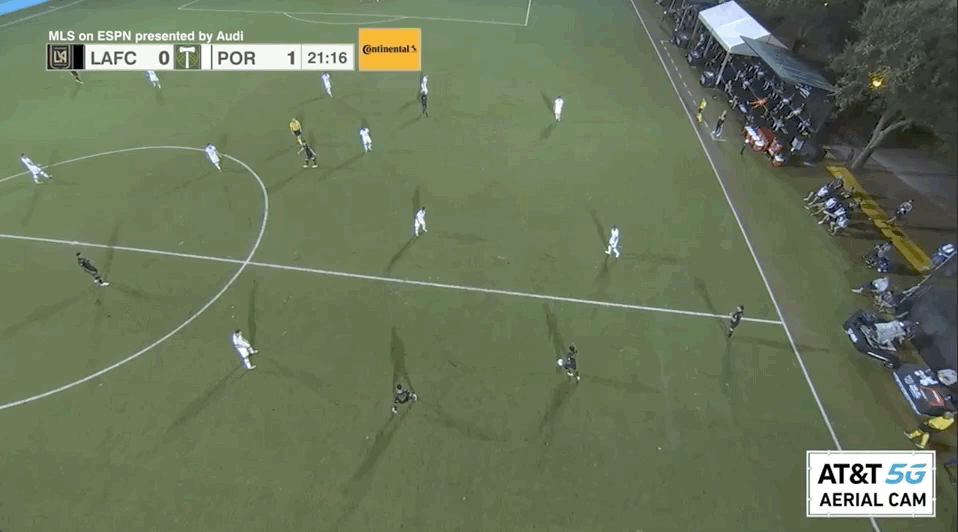
In this clip, the midfield does a good job of stepping up and preventing LAFC to get the ball in a dangerous, central area.
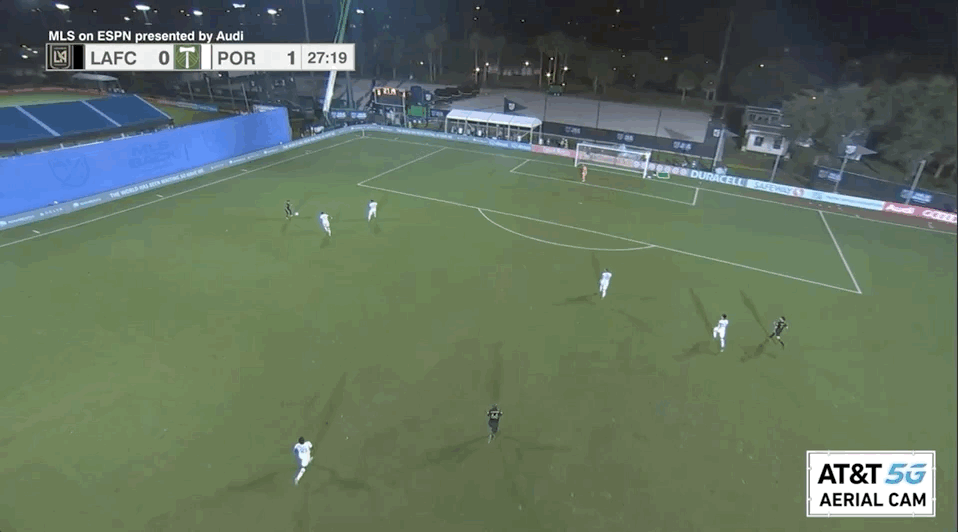
Here, the defense does a great job to cut this pass off as LAFC looks to make a direct pass towards the top of the box.
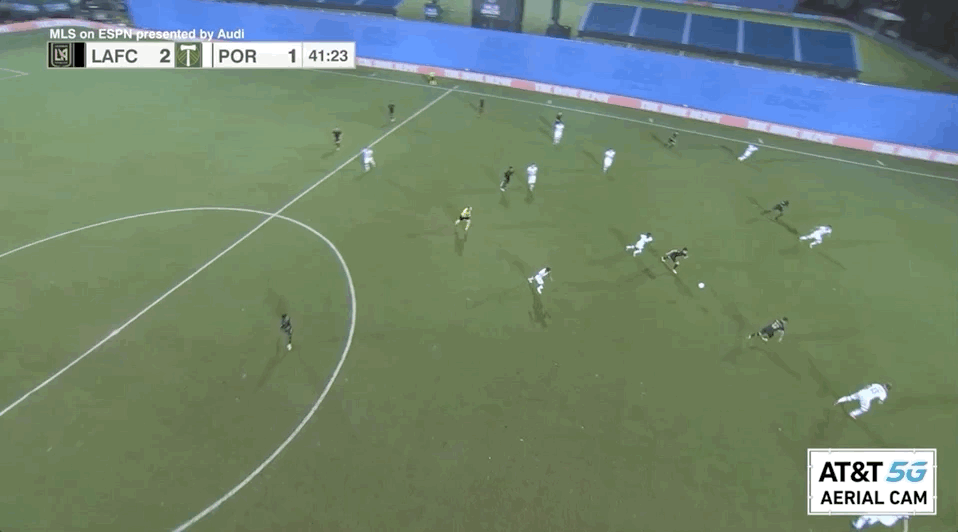
This third example is what happens when you have a defensive midfield of Diego Chará and Cristhian Paredes. Portland wanted to ensure that if LAFC tried to play centrally, they would be punished. And it worked.
defend, defend, and defend some more
There’s so much that I wanted to touch on when it comes to the defense side of the ball that I thought I should separate it into two different sections.
The defensive shape that Portland used was a very compact 4-4-2. How it defended was in a mid-block.
By playing this way, the Timbers invited LAFC to towards midfield before applying pressure. The goal of this is to create space in behind LAFC’s backline, and then take advantage of the aggression to create opportunities by running into this now-vacated area.
The Timbers were relatively successful early on but, from the 30th minute until halftime, players started to get tired, and they stopped playing into the space that they created after winning the ball. This allowed LAFC to implement a counter man-marking system, which continued to win the ball high up the field, effectively trapping Portland in its own half.
“I think what was difficult today was when we lost the ball so quickly,” Diego Chará said after the game. “When we recovered the ball, we tried to play forward, but we missed a lot of passes, and I think that made it more difficult for us to keep the ball.”
All of this is evident in the graphics below.
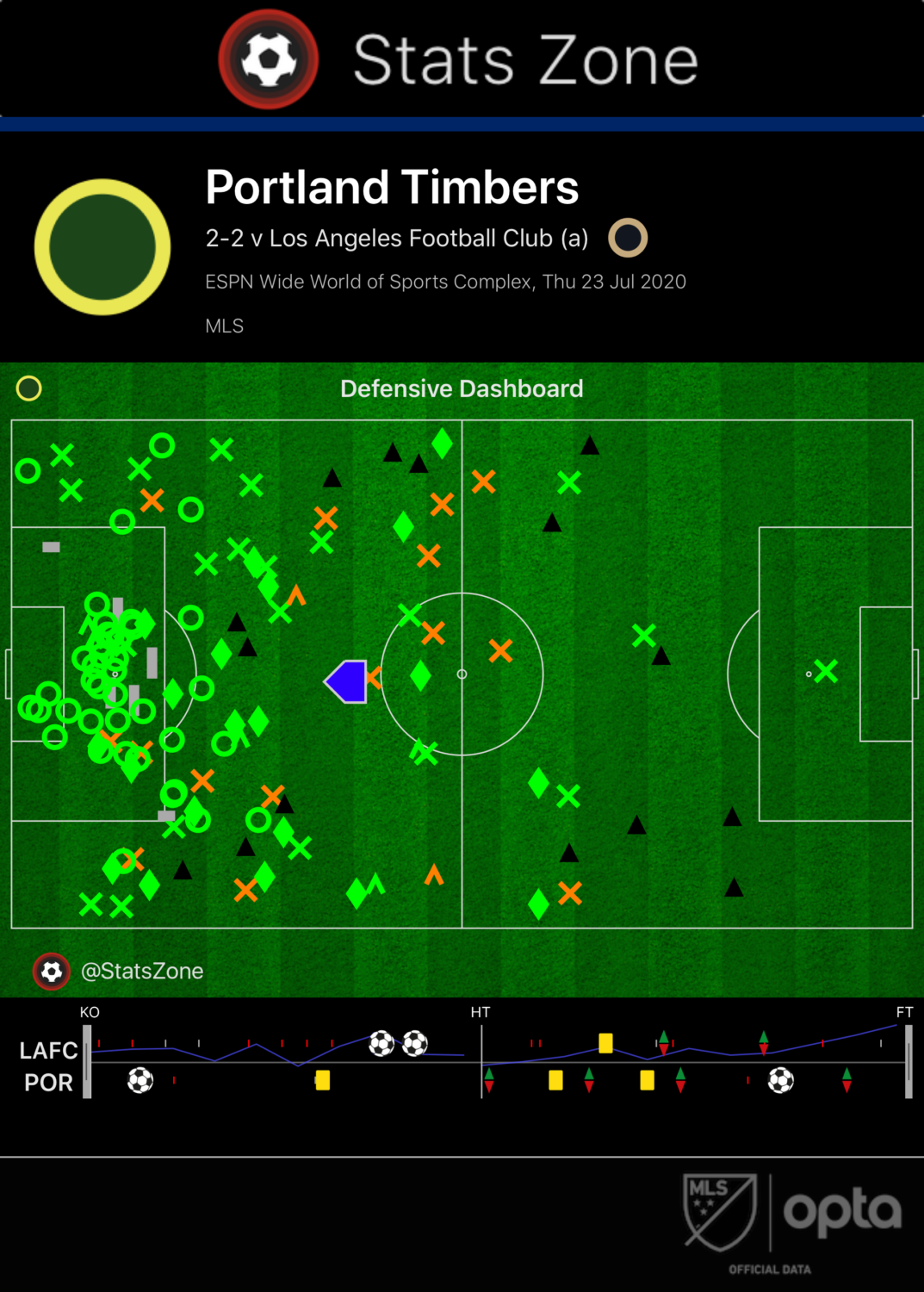
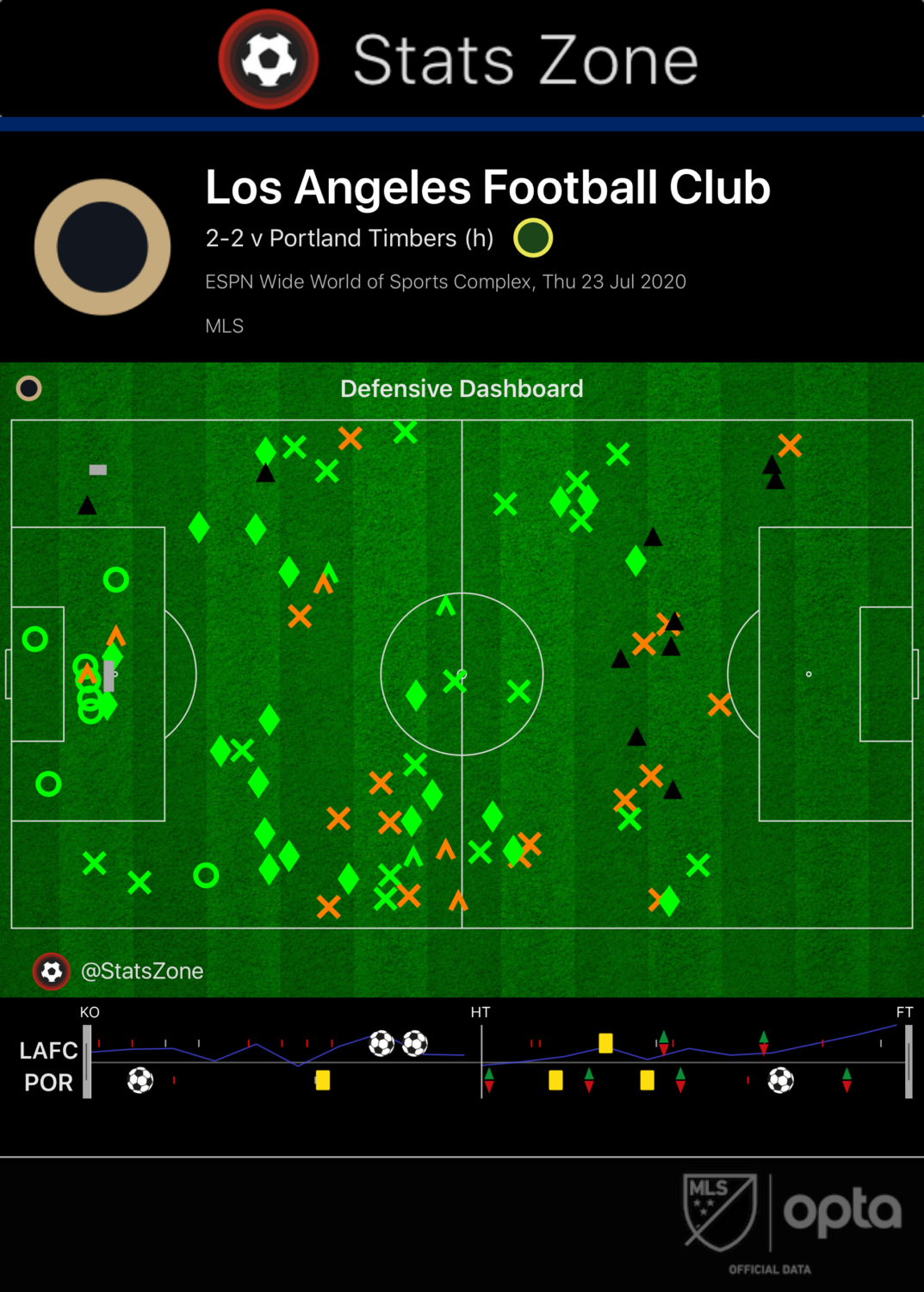
Look at where Portland defends versus where LAFC defends. Portland is playing a dangerous game of bend-but-don’t-break soccer, mostly in its own half, while LAFC is constantly trying to play on the front foot.
I can throw so many more graphics and stats such as the ones above in the article, but I don’t need to. The Timbers put on a defensive masterclass on Thursday night. Sure, it wasn’t perfect, but it’s the type of shape that every team that wants to make a deep run into a tournament needs. It’s important to remember that LAFC can exploit any defensive system and, if the Timbers could look like this defensively every game, they could go quite far in Orlando.
“The first thirty minutes we had the better of the play. We were very tight, and we didn’t allow them to be able to create much,” Savarese said when asked about LAFC’s dominant stretch. “In the last 15 minutes in the first half, they started to find the balls in between the lines; they started making better movements in those areas that we wanted to protect, and we were tired so we couldn’t close those spaces as well as we did the first thirty minutes.
“We also gave up the ball in those moments, different than the first thirty minutes when we had a lot of the ball and were smart in the way me moved it. I think that the two goals were two moments that are a little bit separated from them finding space. Yes, they had a little bit more of the ball in those minutes, they tried to create, but we defended very very well even though we had some players being tired.”
Playing through the press
When a team presses as hard as LAFC does, the opponent usually has two options: A) Try to play through the pressure in hopes to find space to attack into; or B) Stop thinking for a few seconds and clear the ball, praying to find a teammate somewhere in the attack.
In the past, the Timbers would have taken option B, trying to recycle the ball wide and play it long, which often resulted in a quick loss of possession. But these are not the Timbers of old. Against LAFC, Portland invited the pressure and attempted to move up the field through multiple series of intricate passing and combination play. It did not always work, but when it did it was pretty.
Part of playing through a press is knowing when to commit numbers forward after winning the ball versus when to sit back. Whatever the decision is, every player needs to be on the same page to ensure that there are no gaps. Playing into the created space catches a team when they are most vulnerable at the back, but if you lose the ball, there is now plenty of vacated space for the opposing team to exploit.
Above is an example of what happens when a team gambles wrong. Remember the compact 4-4-2 block I pointed out above? This is what it looks like when caught in transition.
“It was a challenge trying to balance [attacking versus defending], understanding that we didn’t want to expose ourselves defensively, but also not wanting to sacrifice the potential for a counter-attack and getting in behind the space that they were leaving,” Jeremy Ebobisse said. “A fine line for attacking players, myself and the wingers, to balance, but ultimately I think that we had some good opportunities on the break.
“That shows a job well done to manage difficulties when they had the ball and were penetrating us and those times we were able to break out, complete a few passes, and unbalance them.”
As Ebobisse eluded to, this is a formula that teams have to get right every game. There were moments in which the Timbers were caught out, like shown above, but overall they put in a solid defensive shift and allowed their attacking talents to find a pair of goals on the other end of the field.
Now it’s onto the round of 16, where FC Cincinnati awaits. One of the surprise teams of the tournament so far, the onus will most likely be put on the Timbers to break down a compact Cincinnati side. If Portland can put together everything that they’ve shown from the group stage of this tournament, advancing to the final eight is a real possibility.
It’s time for revenge.
Video courtesy of ESPN aerial cam. Graphics courtesy of Opta and StatsZone.

